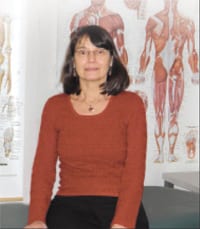Healing Touch Massage Therapy Relieves Stress, Stimulates Body’s Defense System
Many people think getting a professional massage is a way to pamper themselves. But research shows therapeutic massage offers a wide range of health benefits that extend far beyond the hour spent on the massage-therapy table.
“Massage has been looked at as a luxury, and that’s unfortunate because it can play a really important role in keeping people healthy,” said Bernadette Nicholson, director of the Massage Therapy program at Springfield Technical Community College. “It can be a luxury if it is done in a spa and combined with scrubs and rubs. But it has its place in allied health and gives people a general sense of well-being so they can function better in the workplace. Massage has been shown to reduce stress and can be used to help rehabilitate injuries in people who have muscular/skeletal pain.”
Patricia Wachter agrees. “Massage is a skilled form of touch that can help people heal from injuries, whether they are recovering from whiplash or have low back pain from the stress of sitting at a computer all day,” said the coordinator of the Stillpoint Center for Advanced Massage at Greenfield Community College, who also has her own massage studio. “Massage therapists work with many layers of tissue that comprise muscle tissue to relieve scarring and create elasticity where there are adhesions.”
If a massage therapist is working on someone and discovers a bump or thickening in the muscle tissue, it provides him or her with information about the way the person uses that part of their body.
Massage therapy “tells a whole story, which might be how the person is sitting at their computer, the angle of their head while they are looking at the computer screen, how they sleep, the position they are in when they drive, and what side of their body they carry their purse or briefcase on,” Wachter explained. This can be discerned because the muscles in the body tend to align according to the way they are used. And if someone favors one side of their body or uses a muscle in an unnatural way, “over time the muscle starts to have a natural limitation in its range of motion.”
Massage therapy can help restore the natural range of motion by reprogramming muscle fibers. “Massage talks to the muscles,” Wachter said, adding that therapists and clients often discuss postures that contribute to problems, in order to prevent further injury. “We want the muscles to go back into neutral. If the person stays properly aligned and uses their muscles properly and doesn’t fatigue them so they tighten again, it will become their new pattern of posture.”
This makes massage therapy particularly effective in treating conditions such as frozen shoulder or whiplash, which forces muscles far beyond their normal range of motion.
Body Language
Records of massage therapy date back 5,000 years, and the discipline has been employed by many cultures. But the human need for touch was present long before that.
“During the caveman period, people slept together for warmth, which is part of the way our nervous system evolved,” said Alexei Levine, director of the Massage School in Easthampton. “Touch is an integral part of life for humans. But we don’t touch each other anymore.”
Nicholson agreed that touch is important and said massage therapy is often used in palliative-care settings for the elderly and people with serious illnesses such as cancer. “It provides needed touch to people who feel isolated from others and from themselves. When someone is ill, they may detach emotionally from their body, but when they receive a massage, it grounds them back to their body.”
There are many different forms of massage, and knowledge about their health-related benefits are becoming more well-known and accepted, especially with the younger generation.
“We have young people who are coming to us on a regular basis, which wouldn’t have happened 20 years ago,” Levine said. In addition, massage schools across the country are seeing an increase in the number of high-school graduates seeking entrance into their programs.
Wachter said massage therapy is a health profession in its own right. “It’s an approach to wellness and health maintenance as well as one that can help people recover from acute and chronic injuries, diseases, and medical conditions.”
The body’s autonomic system includes the sympathetic and parasympathetic nervous systems. Nicholson explained that the sympathetic system releases stress hormones, and an overload can cause chemical changes that wear the body down and are related to disease.
“If a person is under stress for an extended period of time, it can raise their cholesterol level and lower their immune system and digestive function. It’s well-known that stress can exacerbate any health condition,” Nicholson said, adding that the sympathetic system releases chemicals that put the body in a “fight-or-flight” mode, even though the stress may exist only in the person’s mind.
Massage therapy promotes activation of the parasympathetic system, or healing functions of the body. “Research has shown that massage can increase the hormones that work against stress,” Nicholson said. “It can complement physical, occupational, and chiropractic care.
“You can have your skeleton adjusted, but if the muscles have been held in a chronic pattern, they will be strong enough to pull the spine back to where it was,” she continued. “People report being able to move differently after massage. It allows them to begin to correct distortion patterns that were created over time as a result of their postural habits, and allows them to regain better function.”
Massage therapy also promotes circulation in muscle tissue, especially when adhesions have developed. An adhesion is internal scar tissue that connects tissues that would not be connected under normal circumstances. “It glues them together to make the muscle stronger. But an adhesion means something is stuck and not working right,” Wachter said.
Nicholson agreed, explaining that, if the body is injured, collagen is sent to the area to repair the tissue and can knit together and prevent it from being used in a normal fashion. “Massage can slowly break up collagen in faschia and muscle tissue, then stretch it so it moves properly,” she said.
She used the example of an ACL (anterior cruciate ligament) injury in the knee. “The tissues splint to hold the knee from further injury. But if the knee is still stiff after the inflammation is gone, massage can relax the tissue around the knee and tendon so the person gets a better range of motion.”
Because the body and mind are connected, Levine said, it’s not uncommon for people to experience an emotional release during a massage and start crying. “It can be a very cathartic experience,” he noted, adding that massage therapy can trigger a wide range of memories.
In addition, many people don’t realize how much pain they have been living with until they are touched. “When people have their legs massaged, they have told therapists they have no idea how sore they were until they were touched. We are so out of touch with our bodies.”
There’s the Rub
In order to be certified as a massage therapist in Massachusetts, a person must graduate from a school and have a minimum of 650 hours of training. However, many schools go far beyond this, including the Massage School, whose students are required to complete 800 hours of training before graduation, and STCC’s program, which is accredited and takes 690 hours to complete.
The college also offers an associate’s degree in massage which requires 960 hours of training. “There are no national regulations, so schools vary widely in what they demand from their students,” Nicholson said.
There are many types of massage, which include reflexology, which works on a series of pressure points on the hands, feet, and head. Levine said it is often chosen by people who are not comfortable being touched.
Shiastsu is another type of massage that works with the body’s energy meridians. “It is done while people are fully clothed. There is no stroking or oil used, and the massage therapist works on deep pressure points,” Levine said.
Other varieties of massage include Thai and yoga massage. But with all types of massage therapy, the amount of pressure used is dictated by what the client finds comfortable.
“The number-one complaint from people getting a massage is that the therapist didn’t use enough pressure, while the number-two complaint is that they used too much pressure,” Levine said.
Some people believe that deep pressure is necessary for a massage to be therapeutic, he explained. But it’s a false perception. “People’s muscles get so tight, they believe nothing other than deep kneading will bring them relief. But you can achieve just as much with moderate pressure. It can break up persistent tension in the muscular/skeletal system that can lead to chronic pain,” Levine said, adding that relief provided from a massage can last for a week or longer, especially if people make postural changes.
Although most people receive full-body massages, some choose to have the therapist focus on one area that is bothering them. “Each person needs to discuss his or her therapeutic goals before the massage,” Wachter said, adding that, in many cases, the purpose is simply to release endorphins or “feel-good” chemicals produced by the body.
Soothing Comfort
In addition to health benefits, massage therapy is relaxing. “It’s incredible how good a massage feels,” Levine said. “And in our culture, feeling good is undervalued. We are out of touch with our bodies, but feeling good boosts the immune system.”
And since studies show that the health benefits are real, it’s a form of alternative medicine many people turn to for healing.
“It’s not an answer by itself,” Levine concluded, “but it’s a great piece of a wellness program that includes exercise.”




Comments are closed.